Related Research Articles
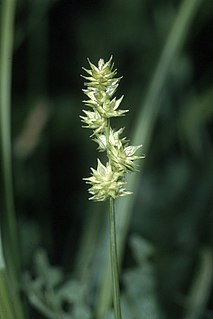
Carex sparganioides, known as bur-reed sedge or loose-headed bracted sedge, is a perennial plant belonging to the sedge family (Cyperaceae). Its native range includes most of the eastern and central United States and eastern Canada. In Maine, it is typically found in hardwood or mixed forests.

Mordella marginata is a species of Mordellidae that occurs in North America.

Pulsatilla nuttalliana, known as American pasqueflower, prairie pasqueflower, prairie crocus, cutleaf anemone, or simply pasqueflower, is a flowering plant native to much of North America, from the western side of Lake Michigan, to northern Canada in the Northwest Territories, south to New Mexico in the southwestern United States.
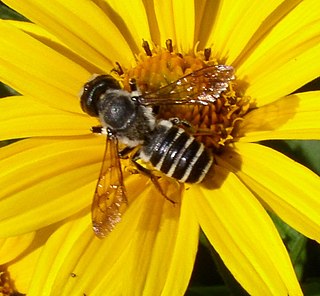
Megachile pugnata is a species of North American bee in the family Megachilidae. It was described by Say in 1837.
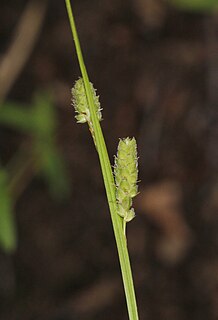
Carex swanii, known as Swan's sedge or downy green sedge, is a species of flowering plant in the family Cyperaceae. It is native to eastern North America.
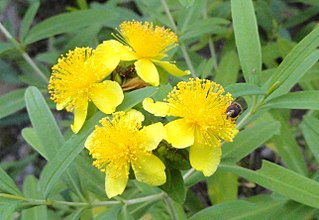
Hypericum kalmianum, commonly called Kalm's St. Johns wort or Kalm's St. Johnswort, is a flowering plant in the St. John's wort family Hypericaceae. It is native to the Great Lakes region in the northern United States and southern Canada. Hypericum kalmianum was named after its discoverer, Swedish botanist Pehr Kalm (1715-1779).
Floristic Quality Assessment (FQA) is a tool used to assess an area's ecological integrity based on its plant species composition. Floristic Quality Assessment was originally developed in order to assess the likelihood that impacts to an area "would be irreversible or irretrievable...to make standard comparisons among various open land areas, to set conservation priorities, and to monitor site management or restoration efforts." The concept was developed by Gerould Wilhelm in the 1970s in a report on the natural lands of Kane County, Illinois. In 1979 Wilhelm and Floyd Swink codified this "scoring system" for the 22-county Chicago Region.

Hypericum swinkianum, known as Swink's St. John's wort, is a shrub in the St. John's wort family. It was named after Chicago Region botanist Floyd Swink (1921-2000).
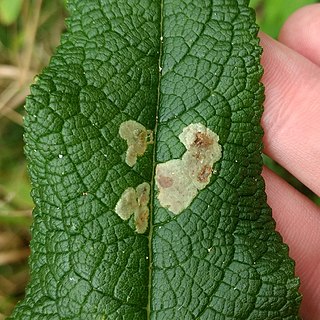
Calycomyza flavinotum is a species of leaf miner fly. It creates whitish blotch-shaped mines on the leaves of Ageratina altissima, Arctium minus, Eupatorium spp., Eutrochium maculatum, and Eutrochium purpureum, all flowering plants in the sunflower family.
Dr. Floyd Allen Swink (1921-2000) was an American botanist, teacher of natural history, and author of several floras of the Chicago region.

A remnant natural area, also known as remnant habitat, is an ecological community containing native flora and fauna that has not been significantly disturbed by destructive activities such as agriculture, logging, pollution, development, fire suppression, or non-native species invasion. The more disturbed an area has been, the less characteristic it becomes of remnant habitat. Remnant areas are also described as "biologically intact" or "ecologically intact."
Laura Rericha-Anchor is an American biologist with expertise in botany, ornithology, entomology, and ecology of the Midwestern United States.

Dichanthelium leibergii, known as variously as Leiberg's panicum, Leiberg's panicgrass, Leiberg's rosette grass, and prairie panic grass is a species of grass native to North America. It was named for its discoverer, John Bernhard Leiberg (1853-1913), a Swedish-born American botanist active in the western United States.

Asclepias lanuginosa, the woolly milkweed or sidecluster milkweed, is a species of flowering plant in the dogbane family, Apocynaceae, native to central Canada and the upper Midwest United States. It was described in 1818. It is a perennial herb that grows 6–12 inches (15–30 cm) tall.
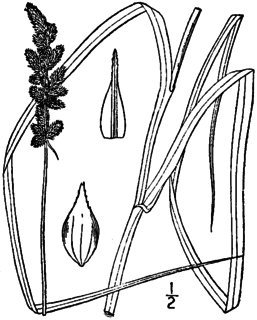
Carex annectens, sometimes called yellow-fruited fox sedge, is a species of sedge native to most of the eastern United States and southeastern Canada. It is common in prairies and high-water table fallow fields. In the Chicago area, its coefficient of conservatism is 3, and in Michigan, it is only 1, indicating its relatively low fidelity to high quality habitats.
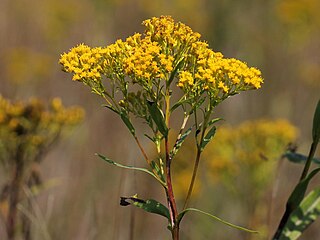
Solidago sect. Ptarmicoidei is a section of flowering plants in the genus Solidago. They are sometimes considered a separate genus: Oligoneuron. Like related species they are known as goldenrods. This section contains seven species of perennial herbs, all native to North America. They are distinguished from other goldenrods by their corymbiform flowerheads, which are flat or rounded in profile and about as broad as tall or broader, for which they are sometimes called flat-topped goldenrods.
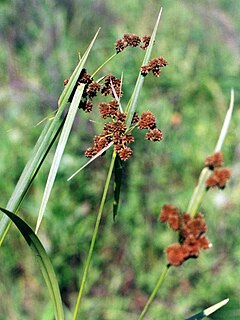
Scirpus atrovirens, known as dark-green bulrush, is a perennial sedge native to wetlands of eastern Canada and the United States. It is sometimes called dark green bulsedge, black bulrush, or green bulrush.
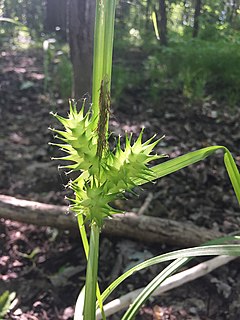
Carex lupulina, known as hop sedge or common hop sedge, is a species of sedge native to most of eastern North America.

Arachniodes aristata is a species of fern in the family Dryopteridaceae. It is a glossy fern with fronds up to 1 m long. The type specimen was collected by George Forster at an unknown island in the Pacific Ocean, when travelling on the second voyage of James Cook. This plant was first formally named Polypodium aristatum in 1786 in the Florulae Insularum Australium Prodromus, published by his father Johann Reinhold Forster. The specific epithet "aristata" derives from Latin, meaning "bearing a bristle".
Quercus × bebbiana, known as Bebb's oak, is a naturally occurring hybrid of white oak and burr oak. It occurs where their ranges overlap in the eastern United States and eastern Canada. It was named for Michael Schuck Bebb (1833–1895), an Illinois botanist who specialized in willows (Salix).
References
- ↑ Wilhelm, Gerould; Rericha, Laura (2017). Flora of the Chicago Region: A Floristic and Ecological Synthesis. Indiana Academy of Sciences.
- ↑ Wilhelm, Gerould. "The Origin of Flora of the Chicago Region: A Floristic and Ecological Synthesis". Conservation Research Institute. Retrieved 2018-02-16.
- ↑ IPNI. G.Wilh.